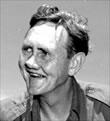LINKING OF EAST-WEST STANDARD GAUGE RAILWAY
Broken Hill, N. S. W. 29 NOVEMBER 1969
Spech by the Prime Minister, Mr. John Gorton
Mr. McCusker, Mr. Mayor, the Hon. the Premiers of New South Wales
and South Australia and Parliamentary Colleagues both Federal and State
and Ladies and Gentlemen:
Mr. Askin, Mr. Hall and I have each -just driven a dog
spike, suitably embellished with gold or silver plate, into the track at the
back of us. It is not for me to say how skilfully we did the job:' I think
we were assisted by the fact that the hole was probably bored out beforehand
for us to put the spikes into: But at least they went in, and that means
that officially the East-West Standard Gauge Railway is just about complete.
On the 12 January, the first through train will journey across
this country unimpeded by break of gauge, and travelling in 65 hours some
2, 500 miles across a bridge of steel which spans this continent and which
serves and will serve not orly as a bridge but as a tie that binds.
Each of the Premiers and myself have, I think, some
special right to be present and to meet you and to take part in this ceremony.
Mr. Askin has a right because Broken Hill is a part of New South Wales
and, theoretically at any rate, subject to the laws of New South Wales.
Mr. Hall, because Broken Hill can really be regarded almost as a suburb
of Adelaide, being only some nine hours away. And myself, I think, because
the Coalition Government some time ago took the first steps in the work
which came to fruition today and is providing something like half the
financial cost of it.
For the first time in more than a hundred years, this bridge,
this tie will be operating, and it will add a new dimension to the East-West
traffic; it will open a new chapter in our history. It is not possible today
to name all those who have played their part in the effort which came to
fruition today, but inevitably the names of the late Sir Harold Clapp, the
late Mr. Eddie Ward, the Minister for Transport in a previous Government,
and I think above all, my own Ministerial colleague, Mr. Wentworth,
come to mind. It was Mr. Ward who first started negotiating with the
States in these matters, and it was Mr. Wentworth who chaired the
Government's Parliamentary Committee on Standardisation I am not
sure that that Committee was ever appointed with the approval of the
then Government but it went ahead anyway under Mr. Wentworth' s
guidance. And it was the work of that Committee and the response by the
Commonwealth and State-Railways Commissioners who joined so
wholeheartedly in this co-operative effort which led to getting the same
gauges on the main Australian trunk routes. It is very fitting indeed, I
think, that Mr. Wentworth should be with us at this ceremony. / 2
-2
What I have been speaking of is something that has been
done, and since it has been done it is virtually a part of the past, so we
should turn our eyes to the future. And in this field of transport in the
future, there are three more projects coming up, coming rapidly up.
The first is the construction of a new railway from Port
Augusta to Whyalla which will give Whyalla its first rail link with the rest
of Australia. The second is the construction of a standard gauge connection
to Adelaide from this East-West line which will take three years and cost
some $ 50 million. The third is a study of proposals for a new standard
gauge line to Alice Springs to eliminate the break of gauge at Marree and
to avoid the disruptions to traffic which natural disasters from time to
time have caused. These are continuing steps in the development of our nation,
and I would stress two things about them. One is that transport costs in
Australia have been, and are, a major factor in the whole of our business
and commercial activity and in the prices at which goods are finally sold.
These costs represent a greater part of national expenditure than do the
transport costs of most industrial and developed countries, and this must
present a continuing challenge to all Governments State and Federal
to all citizens, to all those engaged in the work of seeking to overcome
this transport cost imposed upon us. If we can overcome it together, we
will have taken one of the great steps forward towards reducing the costs,
the final cost of things which people buy.
And the second thing I want to stress is that in the field of
transport, whether it be by air or by sea, or by land by rail
developments such as we are seeing today will continue and help to make
us think as one nation. It is one thing to say that a people is indivisible,
that the nation is indivisible, but it is another to know in practical terms
that this in fact is so in the minds of all its citizens. And I think this work
will help to knit us together.
I congratulate all those who have taken part in the planning
and construction of this standard gauge right down to the fourth-last dog
spike that has been hammered into the track. The job has been well
planned, well done and will, for all the future of Australia, be a great
contribution to the nation.
I wish all those who use this trans-continental railway
safe, fast and comfortable travel, and I think that you all realise, you
here today, that you are in fact, as you are, taking part in a really
historic ceremony.

